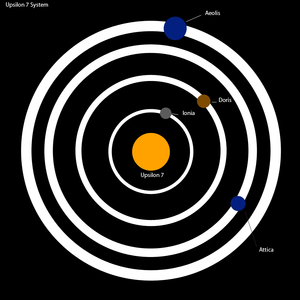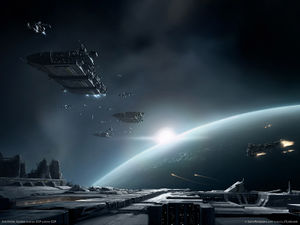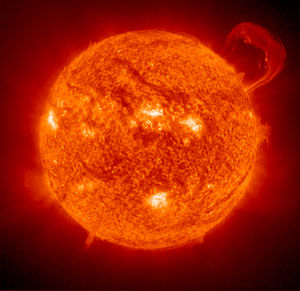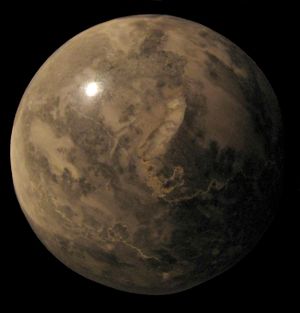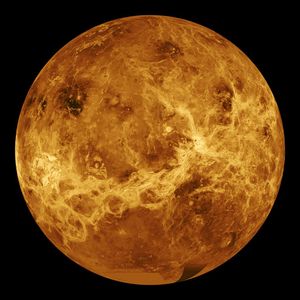Difference between revisions of "Elysium System"
m |
m |
||
| Line 1: | Line 1: | ||
[[File:Elysium-System.png|thumb|300px|Elysium and the Planets orbiting it]] | [[File:Elysium-System.png|thumb|300px|Elysium and the Planets orbiting it]] | ||
| − | The '''Elysium System''' ( {{wp|Greek language|Greek}}:Ἡλύσιον Πλανητικόν Σύστημα, [[Ǽsternðaal]]: | + | The '''Elysium System''' ( {{wp|Greek language|Greek}}:Ἡλύσιον Πλανητικόν Σύστημα, [[Ǽsternðaal]]:Elysium sólkerfar, {{wp|Hungarian}}:Elyszium naprendszer, {{wp|Latin}}:Solis autem Elysium ) ( previously known as the '''Upsilon 7 System''' ) is a star system located 8 [[Wikipedia:Light-year|Light Years]] away from our [[Wikipedia:Solar System|Solar System]] about 80 trillion kilometers away from [[Wikipedia:Sun|Sol]]. It consists of 5 [[Wikipedia:Astronomical object|Celestial Bodies]] not including asteroids and comets. In the center of the system is [[Elysium]], a star hotter and larger than Sol. The star, just like the system is named after the Greek Mythical {{wp|Elysian Fields}}. Around it are four Planets the largest being [[Planet Aeolis]] with an Earth-Like Atmosphere, capable of supporting wild native life. The four planets are [[Planet Ionia|Ionia]], [[Planet Doris|Doris]], [[Planet Attica|Attica]] and [[Planet Aeolis|Aeolis]]. Strangely enough all planets in the system are [[Wikipedia:Terrestrial planet|Terrestrial]], thus no [[Wikipedia:Gas giant|Jovial Planet]] exists in the system, something that made scientists gasp once again at the diversity of the universe. An asteroid belt exists beyond Planet Aeolis and it marks the end of the system. |
== Discovery and Exploration == | == Discovery and Exploration == | ||
Revision as of 10:50, 9 October 2014
The Elysium System ( Greek:Ἡλύσιον Πλανητικόν Σύστημα, Ǽsternðaal:Elysium sólkerfar, Hungarian:Elyszium naprendszer, Latin:Solis autem Elysium ) ( previously known as the Upsilon 7 System ) is a star system located 8 Light Years away from our Solar System about 80 trillion kilometers away from Sol. It consists of 5 Celestial Bodies not including asteroids and comets. In the center of the system is Elysium, a star hotter and larger than Sol. The star, just like the system is named after the Greek Mythical Elysian Fields. Around it are four Planets the largest being Planet Aeolis with an Earth-Like Atmosphere, capable of supporting wild native life. The four planets are Ionia, Doris, Attica and Aeolis. Strangely enough all planets in the system are Terrestrial, thus no Jovial Planet exists in the system, something that made scientists gasp once again at the diversity of the universe. An asteroid belt exists beyond Planet Aeolis and it marks the end of the system.
Contents
Discovery and Exploration
In 2153 a Greek astronomer, Alexander Papadopoulos, noticed the system and started analyzing in through the Galaxy Space Telescope, a vast space telescope orbiting the Earth. Soon enough he found out that the system contained an Earth-like planet and immediately he announced the news to the scientific community, efficiently boosting his reputation to exorbitant heights. Soon enough The Hellenic Republic set off to colonize the planet in 2179 with the Hellenic Colonization Fleet 17. However, after escaping a pirate attack close to Planet Eris the fleet was separated from the world in the System and couldn't return. There the ships crashed on planet Aeolis beginning civilization from zero. After having explored the entire planet and 100 years later, the colonists who had formed the Empire of Rethymnon ( now a Federation ) managed to connect back to the universal system of communications, sharing information about the system, its planets and the conditions dominant on them. Currently the Rethymnian Federation is the only force in the system which works around the clock for the full utilization of its potential.
Celestial Bodies
Elysium
Elysium is the star located at the center of the System. It is larger and hotter than Sol. It is classified as a G IV class Subgiant ( see : Wikipedia:Hertzsprung–Russell diagram ), with 3 times the Sun's luminosity and 1.5 times its size. As a star it has just passed into "adulthood" meaning that its now past its earliest phase and is closer into becoming a Red Giant though its growth is significantly slower than that of the Sun meaning that the star has approximately 3 billion years of life remaining. Scientists believe that the star will most likely grow into a Supergiant engulfing the entire Solar System. This fact also presents the terrifying possibility of a Supernova happening so close to our Solar System, though it is agreed that the earth will be long gone by then.
Ionia
Planet Ionia is the first planet orbiting Elysium. It has a light atmosphere that consists entirely of Carbon Dioxide. During the day it has scorching temperatures touching about 500 Celsius degrees while during the night it drops down to -210 degrees Celsius. The planet is larger than Planet Mars and has a similar red color. Its atmospheric pressure is about 50 atmospheres, 50 times that of the Earth, enough to crash the hull of a ship in seconds. Its skies are reddish-orange. Due to its fast rotation around its axis the planet's surface is almost flat with the tallest entities being hills no taller than 100 meters. The planet's colonization or even the attempt of terraforming it has been labeled as vain and no proceedings are to be made according to scientists, since the position of the Planet itself cannot possibly allow colonization except if it is moved further away from Elysium, a technology no one yet possesses. The Planet has no natural satellites or man made satellites orbiting it.
Dorida
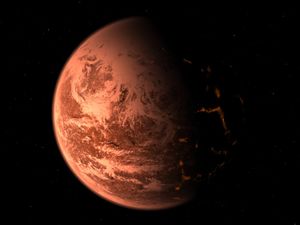
Planet Doris is the second planet orbiting Elysium. It has a mediocre dense atmosphere which consists mainly of Carbon Dioxide and Methane. It has an obvious Greenhouse Effect which keeps deteriorating its already unfriendly state. Planet Doris' surface is as diverse as the Earth's is and its atmospheric pressure is about 3 atmospheres, barely sustainable by humans. Its temperatures are very high, the mean temperature being 100 degrees Celsius. Although the planet is 1 Astronomical Unit away from Elysium (exactly the Earth-Sun distance) its extremely hot due to Elysium's greater heat emission and luminosity. The Planet orbits the Doris Orbital Supply Space Station or DOSSS, a center of a possible future planet terraformation for colonization by the Rethymnian Federation which launched the station. Other than DOSSS, no other man made or natural body orbits the planet.
Attica
Planet Attica is the third planet orbiting Elysium. It is now an Earth Like planet, however still under terraformation. In 2334, during the reign of the Rethymnian Emperor Xenophon Aidonakis the order of terraformation was issued and the planet will be ready for colonization with an atmosphere identical to that of the Earth. Currently The Federation is putting the last pieces into place. The Planet is exactly the size of the Earth something that couldn't go unnoticed by everyone with the planet also being the third in row away from its star. Many people believe it is no mere coincidence and that the future holds greatness for the planet, many calling it the Second Earth not bearing in mind that less than 100 years ago the planet was a barren wasteland with no water or atmosphere. The Planet has no moons yet however the Rethymnian Federation is discussing whether to construct a spherical space station or not for overseeing the planet's development. The Planet has five continents, Rhodesia, Laurasia, Deleron, Lentron and Getron and three oceans, the Aegean Ocean, the Attic Ocean and the Aeolian Ocean. The most amazing feature of Attica are its rings of asteroids, which makes the planet the first terrestrial, habbitable planet with a Planetary Ring System.
Aeolis
Planet Aeolis is the fourth planet orbiting Elysium. It is a naturally occuring Earth Like planet colonized by castaways from the Hellenic Colonization Fleet 17, who after crashing on the world made it their homeland by evolving it into a modern, industrialized, lash world with green technology ensuring its longevity. The heavy industry in nowhere to be found with environment-friendly technology sprawling left and right. The colonists founded the Federation of Rethymnon, the dominant power within the Elysium System. The Planet's size is four times that of the Earth. It has three continents, Lention, Erelion and Zetron with one massive ocean, the Panatlantic Ocean surrounding them. During the first days for industrialization its Fauna and Flora was wiped out but now seeds from the Earth as well as animals have recreated the food chain. The Panatlantic Ocean is almost twice the size of the Earth and holds many unknown spieces in it which will most likely never be discovered. The Planet's population hasn't even reached a billion, which is too small for its size and Rethymnian cities are scattered to far from one another though transportation from place to place can be very quick and effective. The planet's temperature is the standard of 24 degrees Celsius. Also its min and max temperatures are similar to those of the Earth.
Formation
Scientists estimate that the formation of the Elysium System is similar, if not identical to that of our own solar system, though still research is being made on why no Gas Giants or Ice Giants ever developed in the system.
